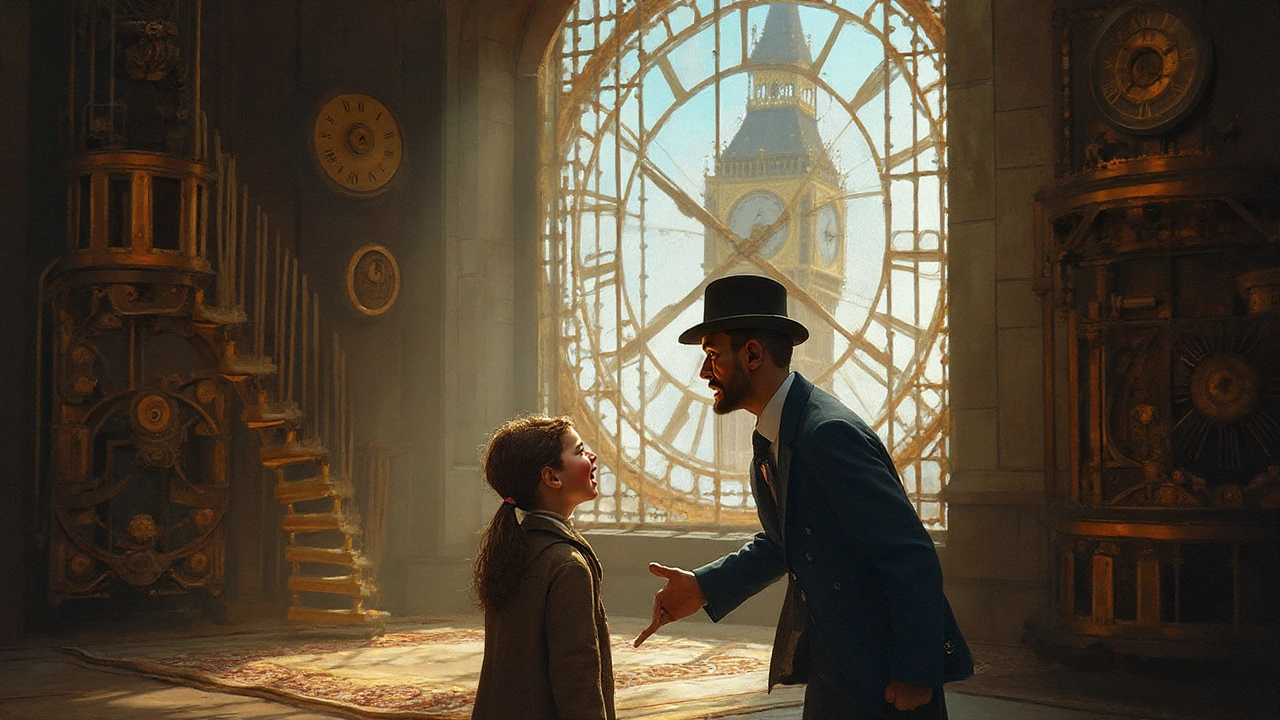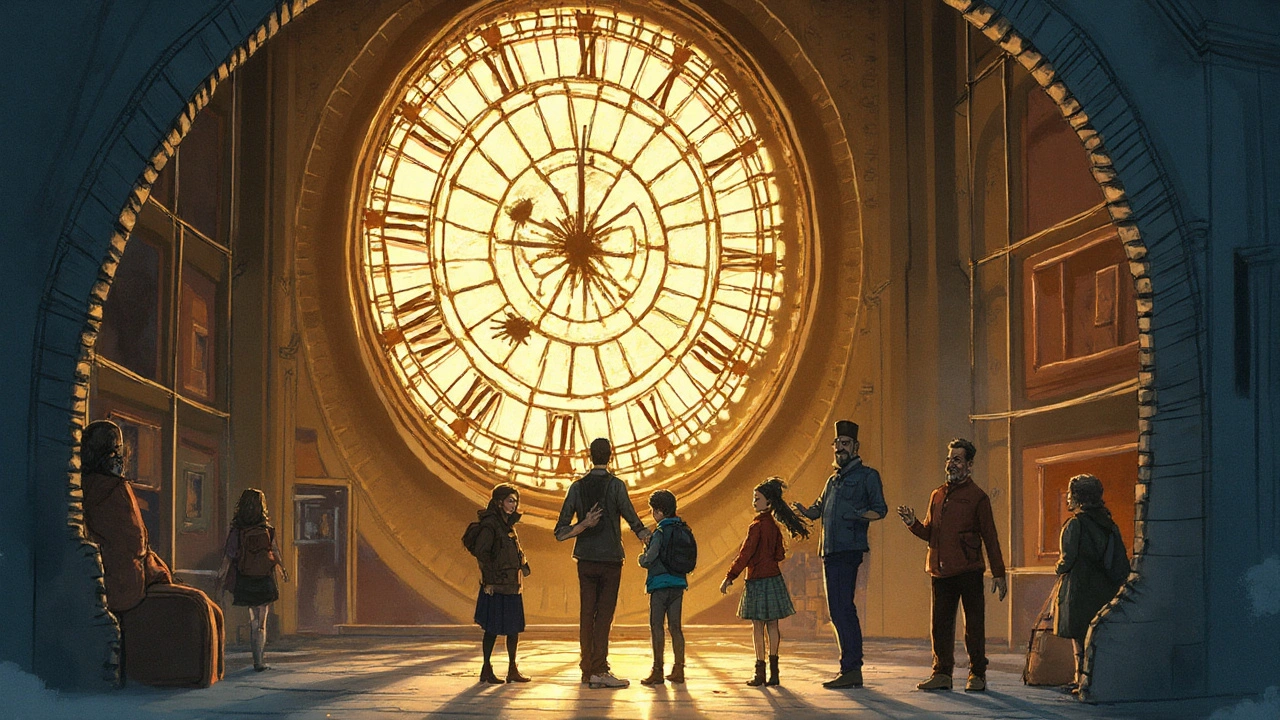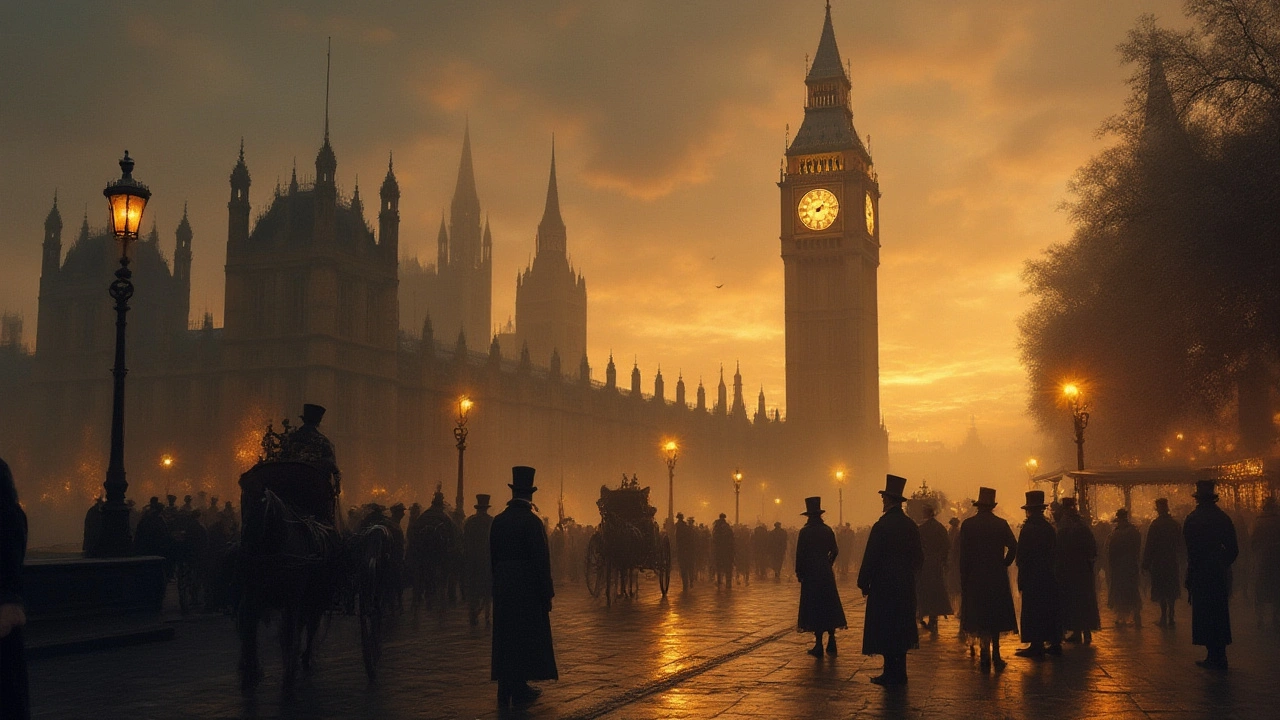Big Ben Unveiled: The Real Story Behind London's Most Famous Landmark

Big Ben gets more Instagram time than any other London landmark, but what you see from Westminster Bridge isn’t even half the story. London's most famous clock isn’t called Big Ben at all—it’s the nickname for the Great Bell inside the Elizabeth Tower, which stands attached to the Houses of Parliament. For Londoners, the image of this clock against the skyline is as familiar as red buses or the sound of the Tube. Yet, most people walking across Westminster hardly stop to think about the daily rituals, odd traditions, and drama that unfolds behind that clock face every single day.
The Hidden Mechanics: Inside the Elizabeth Tower
Everyone in London has heard those deep chimes marking the hour, but behind the sound is a complicated orchestra of Victorian engineering. The Elizabeth Tower stands at 96 meters, which you only realise is a death sentence to your knees if you manage to snag one of the rare tours locals can book through their MP—no lift, just 334 steps up a spiral staircase narrower than the stairs at your nan’s. The clock mechanism itself, built by Edmund Beckett Denison and clockmaker Frederick Dent in 1859, still runs like clockwork (pun fully intended) thanks to a crew of horologists who maintain it.
Every week, a technician winds it up by hand with a cranked handle—it’s hardly digital. Let’s be clear: even a tiny coin on one of those great pendulums can shift the time. Until just before the 2017 restoration, engineers famously used old pennies to fine-tune the clock speed. Knock a penny off? The clock runs faster by two-fifths of a second a day. It’s these little quirks that make Big Ben not just a machine, but a living part of London’s daily rhythm.
And talking about that massive bell, it’s got a fracture from where it was first installed. That’s why you get that unique (some say slightly flat) sound, which has been the heartbeat of national events—from ringing in a new monarch to standing silent for Remembrance Day.
Now here’s a tip: if you want to see this ancient bit of British engineering up close, you have to be a UK resident and plan ahead. MPs nominate small groups, usually from local community organisations or charities, so get in touch with your local constituency office. No, you won’t get a cheeky selfie with the bell, but you can watch the clock hands move from behind the face, which is like flying inside your own time machine—without the Tardis.
Icon on Stage: Big Ben’s Many Roles in London Life
When you live in London, Big Ben is more than a timepiece—it’s the backdrop for everything from royal weddings to protests that draw crowds to Parliament Square. For most people, its chime signals both routine and rupture. The clock rang straight through the London Blitz in WWII, an act of defiance broadcast around the world by BBC radio. You can still listen for it during New Year’s Eve, right before the madness on the South Bank with fireworks over the Thames.
You’ll see the clock’s face light up during State Openings of Parliament—a tradition that started years before selfie sticks. The clock stopped during the Great Smog of 1952 and, more recently, fell silent from 2017 to 2022 when the tower went through a serious facelift. People moaned about missing the chimes, but at the same time, Londoners took pride in the restoration work. They even discovered original graffiti from Victorian workers scrawled behind the clock faces—proof that builders in every age like to leave their mark.
Culturally, Big Ben pops up everywhere: you’ll find it in sketches by local street artists along the South Bank, as a chocolate mold at Fortnum & Mason, and even tattooed on arms outside tattoo shops in Camden. The bell is more than a symbol—it’s a character in the London story. If you grew up in the UK, chances are you heard it in children’s programmes or remember it in the background when your grandparents turned up ‘the pips’ on Radio 4 to mark the hour.
For London photographers, the tower is tricky—morning mist can make a shot from Lambeth Bridge ethereal, while golden hour brings out those Victorian details. Early risers get the best view, and those looking for a pint after should pop into nearby pubs like The Red Lion, where Westminster history lines the walls.

Fun Facts, Numbers, and Quirks: What Locals and Tourists Don’t Know
Ask most Londoners about Big Ben, and they might give you the basics—it’s big, it’s old, it’s part of Parliament. But dig a little deeper, and you hit a goldmine of good trivia. The whole Elizabeth Tower leans ever so slightly northeast, about the height of a small child—so, yes, London does have its own leaning tower. The dials use glass made by the same company that created the iconic red telephone box—Hartley Wood. Each clock face measures 7 meters across, almost the length of a new Routemaster bus.
You’d think something this huge would be easy to clean. Nope—it takes teams of abseilers, the same crews who sort out the Shard windows, to keep those faces sparkling. They sometimes time their work to charity events or just before big political happenings, as nobody wants a dusty Ben on TV around the world.
Now, about those chimes: the big bell weighs 13.7 tonnes, and you can hear the striking up to five miles away on a quiet day, especially with a favourable wind. The clock was famously only wrong twice in its lifetime: once when a flock of roosting starlings slowed the minute hand in 1949, and once when a snowstorm jammed it in 1962. The rest of the time? Blame local pigeons. Even today, technicians have to shoo away birds or risk another unexpected delay.
If you're a numbers person, have a look:
| Fact | Data |
|---|---|
| Height | 96 metres |
| Number of Steps to Belltower | 334 |
| Weight of Big Ben (the bell) | 13.7 tonnes |
| Diameter of Clock Faces | 7 metres |
| Year Built | 1859 |
Love a bit of local economy stuff? Those chimes feature in everything—from high-end London cocktail bars using them to mark closing time to the queues outside popular Westminster cafes. Tourists pile into the area expecting something grand, but locals know the best views sometimes come during those random, misty autumn evenings, when the tower beams golden like a lighthouse in the city centre.
Pro tip: those hop-on-hop-off buses love telling tales about it. But if you want a quieter experience, stroll over Westminster Bridge after sunset. The crowds thin out, and you can actually hear the soft hum of the city—and maybe, just maybe, a faint echo of those historic chimes.
How to Experience Big Ben Like a Real Londoner
If you’re after the magic that locals know, Big Ben is best soaked up during those ‘ordinary’ moments everyone else ignores. Nip down to the embankment during a drizzle, and you’ll see its reflection shimmer in the Thames. Grab a takeaway coffee from Monmouth Coffee in Borough and sip as you walk up Whitehall for a sneaky side view of the tower that’s less photographed but just as striking.
On New Year’s Eve, crowds pack Victoria Embankment for the big midnight chime—but you don’t need to fight the masses. Try Southbank Centre’s rooftop bar, where you can hear the bell while watching fireworks across the river. Bring mates, make a night of it. During Wimbledon, pubs near the river like The Camel & Artichoke often sync coverage with the chimes, so every ace or drama on Centre Court feels a bit more epic.
Locals tip: catch the Westminster tube early before the rush, and watch as sunlight streams through the arches with the tower looming up. On Remembrance Sunday, pause on Westminster Bridge at 11 am when the chimes stop—the entire city seems to hold its breath, and it’s one of those moments that make you feel the weight of history pressing in on modern life.
For families, join one of the walking tours run by qualified Blue Badge guides. These aren’t your average tourist shuffles; guides often have stories from childhoods spent in the area, or tidbits learned from old relatives that you won’t find in guidebooks. If you prefer solo exploring, use the TfL London Bus app to hop off at Parliament Square, then weave towards Smith Square for quieter streets. You might stumble into a street musician setting up—Big Ben as a backdrop makes even Dylan covers sound epic.
For those who love their history with a side of modernity, download the official UK Parliament augmented reality app. Point it at the tower, and you’ll see layers of history unfold, from Queen Victoria’s time to the major repairs after the 2016 cracks appeared. It’s free and a local favourite among students and parents looking for a rainy-day adventure.
One last tip. If you want to impress those Londoner mates or just look slightly more in-the-know the next time you walk past, drop this line: The Big Ben you see today survived bombings, pollution, snow, and even a slight lean, but it’s kept running because Londoners refuse to let it stand still. And that, right there, sums up the city’s soul—always moving, always surviving, never missing a beat.

somya katiyar
August 6, 2025 AT 14:04Wow, I always thought Big Ben was just a giant clock and that was it. This post makes me think about how much history and engineering goes into something so iconic. I wonder how often they actually have to maintain the clock mechanism inside the tower?
Also, it’s interesting to think about the stories that the tower could tell. It’s like this silent witness to so many historical events and changes in London over the years.
Does anyone know if visitors are allowed to tour the inside near the clock face? That would be quite the experience, especially to see those unseen quirks mentioned.
I’d love to know more about how the clock is powered—does it still rely on old mechanical parts, or has it been upgraded with technology? This kind of blend between the antique and modern is fascinating.
Thanks for sharing a peek behind the scenes. Now I’m inspired to read more about London landmarks and their hidden histories!
Olga Jonkisz
August 7, 2025 AT 14:04Honestly, I find it absolutely pathetic how most people just gloss over Big Ben like it’s some run-of-the-mill clock. Like, do people even grasp the sheer grandeur and complexity behind such a structure? It’s beyond me how Londoners don’t flaunt this masterpiece with more pride.
And "secret life, stories, and unseen quirks"? I hope this article does blow the lid off all those pedestrian assumptions.
Let’s be real: Big Ben symbolizes so much more than just timekeeping. It’s a beacon of history, artistry, and pure technical prowess.
Anyone who can’t appreciate that clearly hasn’t taken a single moment to understand the cultural fabric it weaves into London itself. I’m looking forward to what this post reveals, though I doubt many truly deserve the insight.
Either way, I’ll be here, glaring at those who remain clueless about one of the crown jewels of engineering and history.
Leonard Fusselman
August 8, 2025 AT 14:04This topic merits a thorough and precise examination, given the iconic status of Big Ben in both architectural and historical contexts.
To my knowledge, the tower—officially the Elizabeth Tower—houses a Victorian-era clock mechanism designed with exquisite craftsmanship. The internal workings comprise a pendulum and a complex system of gears which have been meticulously maintained since installation in the mid-19th century.
Interestingly, while "Big Ben" originally referred specifically to the great bell, it has colloquially come to define the entire clock tower, a common misnomer in modern parlance.
If exploring its unseen quirks refers to the clock’s precision engineering, long-term conservation challenges, or anecdotal tales of its history, I find this discussion both necessary and enriching.
It would be valuable to include in-depth information on how the clock mechanism has been preserved or modernized without compromising its authenticity.
Renee Bach
August 9, 2025 AT 14:04Love this! Big Ben has always seemed so mysterious to me. I mean, sure, we see it from afar, but the idea of getting up close to the mechanisms that tick away inside just blows my mind. 😲
There’s a quiet magic in knowing that this giant clock not only keeps time for London but has stories embedded in its very gears and bells.
Also, the quirks part makes me wanna know about any little oddities or fun traditions linked to Big Ben. Like, is there a story behind how the bell sounds or how often it’s worked on?
Thanks for sharing this peek behind the scenes. It’s kinda soul-warming to get a little glimpse into something so iconic yet so personal.
Definitely hope to visit someday and see it for myself. Until then, I’m all ears for more cool facts!
Natali Kilk
August 10, 2025 AT 14:04Alright, I have to confess that I get the tiniest bit irritated when people treat Big Ben like it’s just another tourist trap. It’s not merely a clock; it’s an emblem of a storied, layered reality that transcends its cold mechanics.
The artistry, the history, the cultural weight—none of which one can grasp at a glance—demand a deeper appreciation. The clock’s whispering secrets—those 'unseen quirks'—are invitations to unravel a tapestry of time, history, and human ambition.
Now, don’t get me wrong, this is not just about admiration but an intense philosophical musing on temporality itself, the interplay of past and present, captured in metal and sound.
These mechanisms aren’t just cogs; they are the pulse of historical consciousness, signaling through urban noise, marking moments lost and found.
Big Ben is not just on display; it’s an ongoing performance of time’s relentless march, dressed in Victorian elegance and hidden marvels.
F. Erich McElroy
August 11, 2025 AT 14:05Look, real talk — Big Ben isn’t just some old clock everyone drools over. It’s a beast of engineering, a titan that’s stood tall for centuries and still runs like a well-oiled machine. If you think it’s just decoration, you’re missing the entire freaking point.
People glamorize it but never question the nitty-gritty that keeps this thing ticking. The weights, the pendulum swings, the manual repairs — that's real craftsmanship. Modern tech can’t touch Victorian precision, and you can bet your last penny on that.
This article better show the raw realness behind the clock face or it’s just fluff for tourists. I respect Big Ben’s guts, not just the pretty numbers it spits out.
Anyone acting like it’s just a photo-op is sleeping on what “London” really represents.
Timi Shodeyi
August 12, 2025 AT 14:05This post intriguing indeed! The mention of "secret life" and "unseen quirks" evokes a curiosity about the intricate details that make Big Ben more than just a landmark. One wonders about the challenges involved in preserving such an ancient mechanism.
It's also fascinating to consider the maintenance routines and the precision engineering required to keep the clock so accurate.
The cultural significance of the tower is immense, and understanding its inner workings adds layers of respect for those who built and maintain it.
Moreover, learning about any lesser-known anecdotes or historical events tied to the tower would greatly enrich our appreciation.
Looking forward to more detailed insights or technical explanations regarding the clock's operation and histories.
Taylor Webster
August 13, 2025 AT 14:05Not gonna lie, Big Ben has always kinda fascinated me. Like, it’s this giant clock everyone knows but almost no one really knows in depth. I think stuff about the maintenance schedules, the way the mechanisms tick day in and day out — that’s super wild.
Plus the historic vibes, like, it’s seen so much history, wars, celebrations, countless Londoners passing beneath it.
I’d love to hear about any ghost stories or lore connected to Big Ben too. You know, those little mysterious tidbits that make old landmarks alive.
Overall, this could be a really good dive into what keeps the heart of London beating on time, literally.
minakshi gaval
August 14, 2025 AT 14:05Hmm, has anyone ever wondered if there’s more to Big Ben than what the official stories say? Sometimes it feels like these famous landmarks have hidden meanings or secret histories that governments or authorities keep under wraps.
Like, what if those 'unseen quirks' include some coded messages or symbolism tied to London’s power structures? It wouldn’t surprise me if there were layers of stories nobody talks about publicly.
I always feel a bit skeptical when tourists just admire the beauty without questioning deeper aspects.
Still, I’m curious about the technical side mentioned—maybe the article will shed light on that too.
Either way, it’s a reminder to look beyond the obvious and consider all possibilities.
Brittany Parfait
August 15, 2025 AT 14:05This post feels like a breath of fresh air! Big Ben often seems so distant and monumental that it’s hard to imagine its inner workings as something personal or relatable.
The idea of unveiling the ‘secret life’ and stories inside the tower adds a layer of intimacy that many overlook.
I imagine the people who maintain the clock must have a unique bond with it — like caretakers preserving not just a machine but a piece of living history.
There’s something quiet and beautiful about that, isn’t there? A reminder that behind every iconic symbol is a human story.
Can’t wait to read more and feel connected to the heart of London a little more deeply.